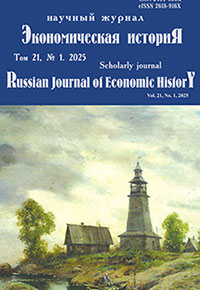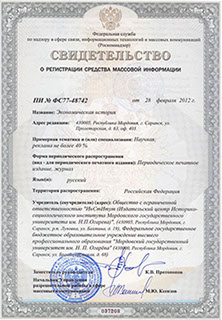Экономическая историЯ
Russian Journal of Economic History
ISSN 2409-630X (Print)
ISSN 2618-916X (Online)
Expert board:
- Scientific Council of RAS on economic history;
- Research and Educational Center «The economic history of Central Russia and the Middle Volga region» of Ogarev Mordovia State University;
- Center of Economic History of Lomonosov Moscow State University
Navigation
Fedor N. Kozlov
I. Ya. Yakovlev Chuvash State Pedagogical University (Cheboksary, Russia),
e-mail: fedor1977@yandex.ru
The Secularization Policy Towards Monasteries as a Factor of the Economic Weakening of the Russian Orthodox Church in the Early Years of Soviet Power (based on materials from the Middle Volga region)
Abstract
Introduction. Monasteries have always played a special role in the structure of the Russian Orthodox Church. Although they live outside the “world”, they are still affected by all the changes taking place in society. Often, it is the monasteries that are the first to feel the mood of those in power. The history of the struggle against monasteries during Soviet Russia is an important part of the process of creating a new social order in this country. It is one of the most tragic periods of the late 1910s and early 1920s.
Materials and Methods. The study is based on a wide range of archival and published materials, as well as unpublished sources. These sources, combined with facts from previous scientific papers, have allowed us to representative reveal the problem of the issue under investigation. The research is conducted using a comprehensive methodological approach, which includes both general scientific and specific scientific methods.
Results. Monasteries, in general, and those of the Volga region, in particular, played a significant role in the spiritual development of the people and served as important centers of spiritual life. Given this, it is not surprising that the authorities of the young Soviet republic had an interest in monasticism as a means of bringing people to faith in Christ and controlling monastic property. For these reasons, it is important to understand the increased attention that the government bodies of the RSFSR paid to monasteries, including restrictions on their rights, secularization of their property, and eventual dissolution.. The real estate of the monasteries was confiscated by decree, and in the Mari, Mordovia, and Chuvash regions, some of it was even looted before the official legalization of expropriation. Food and basic necessities were seized for the needs of local governments and state institutions, while the inhabitants were denied a number of civil rights and social support standards. In 1920, one aspect of the economic pressure on monasteries involved a campaign to open relics, specifically in the region where we are interested. With regard to the remains of Seraphim of Sarov. Simultaneously, the limited opportunities for the financial and economic activities of the monasteries were being addressed, as well as the issue of their eventual complete liquidation.
Discussion and Conclusion. The restriction of the rights and opportunities of monasteries began from the very first days of Soviet power. One of the reasons for this was the special role that monasteries played in relations between the clergy and their followers. A legislative system was gradually formed to transform monks and nuns into so-called “dispossessors”, with a corresponding decrease in their social standing. At the same time, economic pressure was applied through secularization, which was intertwined with ideological struggles. The campaign to open relics was indicative of this process. Monasteries were closed and their buildings were used for educational, medical, and government institutions. By the mid-1920s, monastic life in the Middle Volga region had largely ceased to exist.
Keywords: The Russian Orthodox Church, monasteries, the Middle Volga region, secularization of property, seizure of land, the opening of the relics of St. Seraphim of Sarov, the closure of monasteries.
For citation: Kozlov F. N. The Secularization Policy Towards Monasteries as a Factor of the Economic Weakening of the Russian Orthodox Church in the Early Years of Soviet Power (based on materials from the Middle Volga region). Economicheskaya istoriya = Russian Journal of Economic History. 2025; 21(1): 76–86.
(In Russ.). DOI: 10.24412/2409-630X.068.021.202501.076-086.
© Ogarev Mordovia State University. History and Sociology Institute, 2017
68, Of. 411, Bolshevistskaya St., 430005, The editorial office of the scholarly journal «Russian Journal of Economic History»
Tel.: (8342) 24-25-90; 27-07-11, Fax: (8342) 24-25-90, E-mail: jurnal-econom-hist@isi.mrsu.ru
Designed by A. Napalkov, Email: napalkov@isi.mrsu.ru


